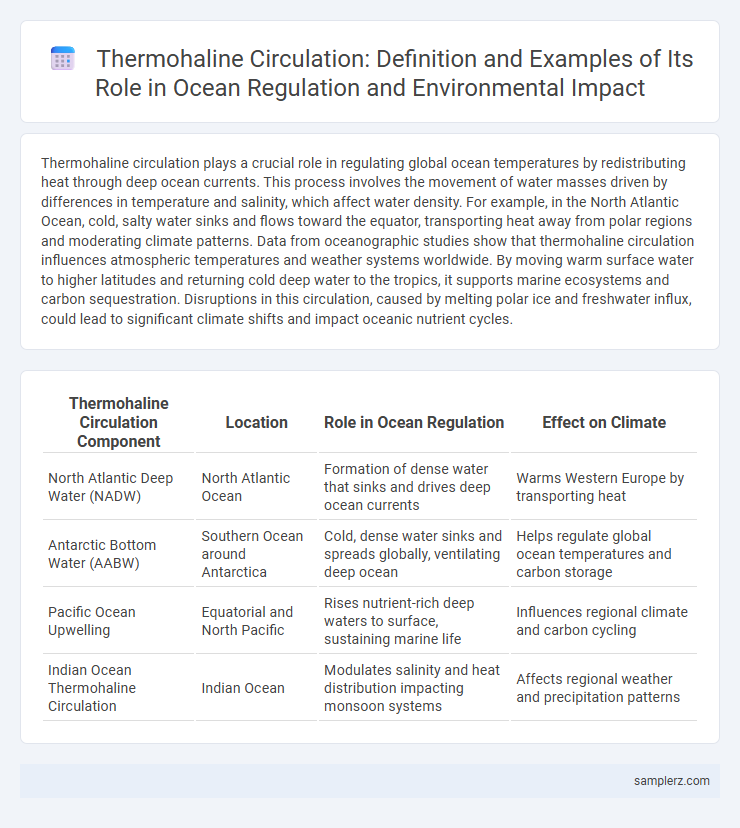Thermohaline circulation plays a crucial role in regulating global ocean temperatures by redistributing heat through deep ocean currents. This process involves the movement of water masses driven by differences in temperature and salinity, which affect water density. For example, in the North Atlantic Ocean, cold, salty water sinks and flows toward the equator, transporting heat away from polar regions and moderating climate patterns. Data from oceanographic studies show that thermohaline circulation influences atmospheric temperatures and weather systems worldwide. By moving warm surface water to higher latitudes and returning cold deep water to the tropics, it supports marine ecosystems and carbon sequestration. Disruptions in this circulation, caused by melting polar ice and freshwater influx, could lead to significant climate shifts and impact oceanic nutrient cycles.
Table of Comparison
| Thermohaline Circulation Component | Location | Role in Ocean Regulation | Effect on Climate |
|---|---|---|---|
| North Atlantic Deep Water (NADW) | North Atlantic Ocean | Formation of dense water that sinks and drives deep ocean currents | Warms Western Europe by transporting heat |
| Antarctic Bottom Water (AABW) | Southern Ocean around Antarctica | Cold, dense water sinks and spreads globally, ventilating deep ocean | Helps regulate global ocean temperatures and carbon storage |
| Pacific Ocean Upwelling | Equatorial and North Pacific | Rises nutrient-rich deep waters to surface, sustaining marine life | Influences regional climate and carbon cycling |
| Indian Ocean Thermohaline Circulation | Indian Ocean | Modulates salinity and heat distribution impacting monsoon systems | Affects regional weather and precipitation patterns |
Introduction to Thermohaline Circulation
Thermohaline circulation is a global ocean conveyor driven by variations in water temperature and salinity, regulating climate by distributing heat and influencing carbon cycles. This deep-water movement begins in polar regions where cold, salty water sinks, propelling a continuous loop that connects surface waters with the ocean depths. Its role in modulating atmospheric carbon dioxide and nutrient cycling highlights its critical function in maintaining Earth's climate stability and marine ecosystems.
The Science Behind Ocean Mixing
Thermohaline circulation drives the global ocean conveyor belt by regulating the mixing of warm, salty surface waters with cold, dense deep waters, crucial for distributing heat and nutrients. This process is powered by variations in water temperature and salinity, affecting ocean density and promoting vertical mixing essential for climate regulation. The exchange of heat and carbon between ocean layers through thermohaline circulation plays a significant role in stabilizing Earth's climate system.
Major Deep Water Formation Regions
The North Atlantic Ocean serves as a primary region for deep water formation, where cold, salty water sinks and drives thermohaline circulation that regulates global climate. The Southern Ocean around Antarctica also contributes significantly by producing dense Antarctic Bottom Water, which spreads into the global ocean basins. These major deep water formation regions are critical in maintaining ocean nutrient distribution, carbon sequestration, and long-term climate stability.
Role of Thermohaline Circulation in Climate Regulation
Thermohaline circulation drives the global conveyor belt of ocean currents, distributing heat and regulating Earth's climate by transferring warm equatorial waters to polar regions and returning cooler waters to the tropics. This deep-ocean process controls carbon dioxide absorption and nutrient cycling, influencing atmospheric temperatures and marine ecosystems. Disruptions in thermohaline circulation can lead to significant climate shifts, such as altered weather patterns and increased frequency of extreme events.
The Atlantic Meridional Overturning Circulation (AMOC)
The Atlantic Meridional Overturning Circulation (AMOC) plays a critical role in regulating global climate by transporting warm, salty surface water northward and returning cold, dense water southward at depth. This thermohaline circulation drives heat distribution across the Atlantic Ocean, influencing weather patterns and marine ecosystems. Disruptions to the AMOC, potentially caused by freshwater influx from melting ice sheets, could significantly alter regional climates and oceanic carbon sequestration.
Impact on Marine Biodiversity and Ecosystems
Thermohaline circulation drives the global movement of ocean currents, redistributing heat and nutrients critical for marine ecosystems. This process supports diverse habitats by regulating temperature and oxygen levels, enabling the survival of species from plankton to large marine mammals. Disruptions in this circulation can lead to habitat loss, reduced biodiversity, and impaired ecosystem services essential for ocean health.
Thermohaline Circulation and Global Carbon Cycle
Thermohaline circulation drives the global ocean conveyor belt, regulating climate by redistributing heat and controlling carbon sequestration. This deep-ocean current transports dissolved CO2 from surface waters to the ocean interior, significantly influencing the global carbon cycle. By enhancing carbon storage in the deep ocean, thermohaline circulation mitigates atmospheric greenhouse gas concentrations and stabilizes Earth's climate system.
Disruptions: Melting Ice and Freshwater Influx
Melting ice from polar regions introduces a significant freshwater influx into the North Atlantic, disrupting the density-driven thermohaline circulation by reducing seawater salinity and altering convection patterns. This disruption weakens the Atlantic Meridional Overturning Circulation (AMOC), a critical component in global ocean regulation and climate stability. Changes in AMOC impact heat distribution, marine ecosystems, and weather patterns across the Northern Hemisphere.
Climate Change Threats to Ocean Regulation
Thermohaline circulation, driven by variations in water temperature and salinity, plays a critical role in regulating global ocean currents and climate. Climate change disrupts this process through increased freshwater input from melting ice caps and rising sea surface temperatures, weakening the density gradients essential for circulation. This disruption threatens to alter heat distribution across oceans, exacerbating extreme weather patterns and jeopardizing marine ecosystems.
Future of Thermohaline Circulation and Environmental Sustainability
Thermohaline circulation plays a critical role in regulating global climate by distributing heat and nutrients across ocean basins, influencing marine ecosystems and weather patterns essential for environmental sustainability. Future projections indicate that climate change-induced alterations, such as freshwater influx from melting ice, could weaken this circulation, disrupting carbon sequestration and increasing ocean acidification risks. Sustaining thermohaline circulation integrity is imperative for mitigating climate impacts and preserving ocean health, highlighting the need for robust climate action and marine conservation strategies.

example of thermohaline circulation in ocean regulation Infographic
 samplerz.com
samplerz.com